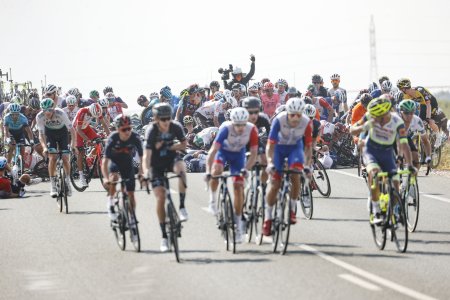Cycling is a sport where victory often hinges on marginal gains. In elite races like the Tour de France, riders are separated by mere minutes after thousands of kilometres, meaning that tactical decisions can be as important as fitness. While power output and aerodynamics are well-known performance factors [1], another crucial, but less visible, element is risk. A crash, even if minor, can end a rider’s race. Can mathematics help optimise racing strategies in a world where both energy and safety must be balanced?
In professional cycling, most of a race is spent within the protective envelope of the peloton, a large group of riders where riders benefit from drastically reduced aerodynamic drag (up to 80% compared to riding alone). However, to win a stage, a rider must eventually break away from this group. This manoeuvre brings two critical consequences: increased energy expenditure and exposure to crash risks. Executing a successful breakaway means navigating a complex trade-off between going early enough to build a time gap, but not so early that fatigue sets in, all the while avoiding a pile up in the peloton. The key question is: how can a cyclist determine the best moment to make a breakaway that maximises both time gain over adversaries and safety?
To answer this, we develop a mathematical model that captures the physics and probabilities involved in competitive cycling. Starting from Newton’s Second Law, the model accounts for forces like aerodynamic drag and power input, while introducing a novel probabilistic approach to crashes. Riders further back in the peloton are more likely to be caught in a crash, as these incidents tend to propagate backwards. The model also incorporates fatigue by considering how power output decays over time due to physiological limitations such as lactic acid build-up.
The core innovation lies in the objective function, which weighs two outcomes: how far ahead the breakaway rider finishes relative to the peloton, and the probability they crash before the finish. This trade-off is controlled by a risk tolerance parameter, which allows team directors to devise customised strategies depending on the rider’s role, be it a cautious overall leader or a risk-prone sprinter hunting stage wins.
By deriving analytical and semi-analytical solutions, we determine the optimal breakaway position for a wide range of conditions, depending on the rider's goal. For instance, a rider hoping to win the entire Tour would want to minimise risk, while a rider who is interested in winning just one stage of the race may be willing to accept higher crash chances in exchange for that win. One of the more surprising results of our model is that it is possible to win a race using less energy than the average rider, by executing a well-timed and high-risk attack.
Our work illustrates how mathematics can guide real-world decisions in elite sport. As races become increasingly competitive and analytics-driven, the ability to quantify trade-offs between energy and safety may offer the crucial edge needed for victory. Whether for team directors mapping out a Grand Tour strategy or athletes preparing for one decisive move, this model offers a rigorous and practical tool for navigating the fine line between heroics and heartbreak.
--
Read more by our case study authors: A mathematical model for optimal breakaways in cycling: balancing energy expenditure and crash risk. Javier Chico-Vázquez & Ian M. Griffiths
[1] L.H. Gaul, S.J. Thomson & I.M. Griffiths. Optimising the breakaway position in cycle races using mathematical modelling (2018) Sports Engineering, 0270-5
Image: the immediate aftermath of a crash (pile-up). Riders positioned ahead of the start of the crash are spared. The crash propagates backwards through the peloton. Credit: Luis Ángel Gómez


